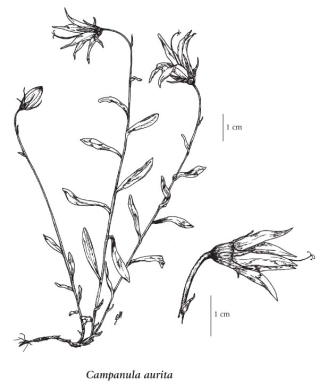Campanula aurita Greene
Alaskan harebell (Yukon bellflower)
Campanulaceae (Bellflower family)
Introduction to Vascular Plants
Alaskan harebell (Yukon bellflower)
Campanulaceae (Bellflower family)
Introduction to Vascular Plants
Species Information
General:
Perennial herb from an elongate rhizome; stems single to several, erect or decumbent to ascending, 10-35 cm tall, short rough-hairy or glabrous.
Leaves:
Basal leaves absent; stem leaves alternate, linear to oblong-elliptic or oblanceolate, 0.8-3.5 cm long, 1-6 mm wide, smooth or irregularly toothed, glabrous or fringed with hairs near the base.
Flowers:
Inflorescence a solitary bell-shaped flower on a rough-haired stalk; calyces glabrous; corolla 12-18 mm long, blue, the lobes spreading or recurved, equalling or longer than the tube; styles exserted from the corolla.
Fruits:
Capsules, inverted cone-shaped to subcylindric.
Illustration

If more than one illustration is available for a species (e.g., separate illustrations were provided for two subspecies) then links to the separate images will be provided below. Note that individual subspecies or varietal illustrations are not always available.
Illustration Source: The Illustrated Flora of British Columbia
Ecology
Ecological Framework for Campanula aurita
The table below shows the species-specific information calculated from
original data (BEC database) provided by the BC Ministry of Forests and Range.
(Updated August, 2013)
The table below shows the species-specific information calculated from
original data (BEC database) provided by the BC Ministry of Forests and Range.
(Updated August, 2013)
| Site Information |
Value / Class |
||
|
Avg |
Min |
Max |
|
| Elevation
(metres) |
2075 | 2075 | 2075 |
| Slope
Gradient (%) |
40 | 40 | 40 |
|
Aspect (degrees) |
270 | 270 | 270 |
| Soil
Moisture Regime (SMR) [0 - very xeric; 4 - mesic; 8 - hydric] |
1 | 1 | 1 |
| Modal
Nutrient Regime
Class |
B | ||
| #
of field plots species was recorded in: |
1 | ||
| Modal
BEC Zone Class |
BAFA | ||
|
All BEC Zones (# of stations/zone) species was recorded in |
BAFA(1) | ||
|
Source:
Klinkenberg 2013
|
|||